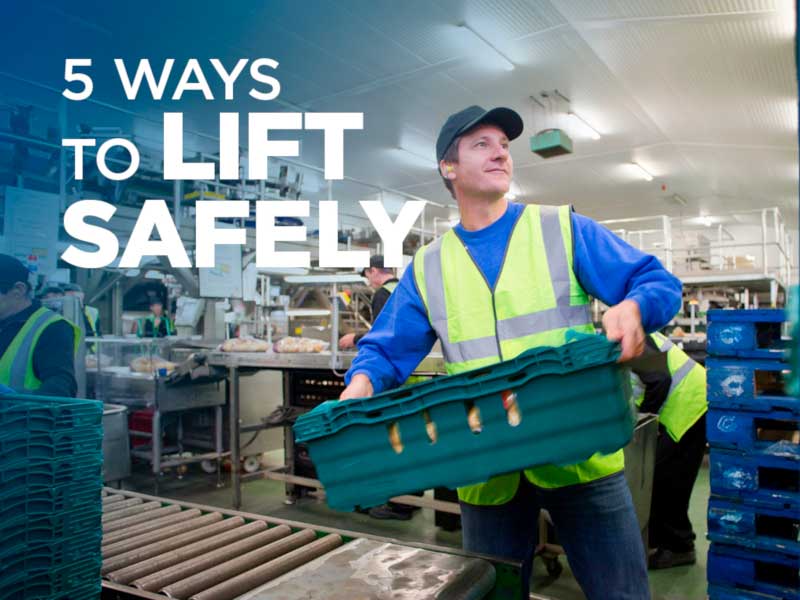- Home
- Loss Control
- Loss Control Insights
- Lift With Your Legs: 5 Ways to Lift Safely
It’s estimated that one of every five workplace injuries is back related. And many of those back injuries are caused by improper lifting. While not an easy task, it’s well worth your time to help employees protect their backs. Back injuries range from one-time exertion injuries, such as torn tendons and ligaments, to subtle but dangerous micro injuries that compound with every improper lift.
Think of your body as a bucket. Micro injuries from work and other activities drip into your bucket. Over time, if you place more micro injuries into your bucket than what your body can naturally heal, the bucket overflows and you may develop more serious injuries.
Lifting correctly is essential for protecting your back. The phrase “lift with your legs” is common, but unfortunately not fully understood by workers or supervisors.
The Force Within You
The first point to understand is how back lifting—lifting with a bent over posture—results in a huge force multiplication of 10:1 on the lower back. This means that lifting a 10-pound box from a fully bent over posture exerts 100 pounds of force on the lower back, while a 100-pound box exerts 1,000 pounds of force.
Combine this with lifting repetitions, and back injuries are often the result. The National Institute for Occupational Safety and Health suggests that 51 pounds is the maximum safe lifting weight under ideal lifting conditions (which rarely occur) for most workers.
There are several lifting methods that help protect workers’ backs if performed correctly. These methods shift much of the force to sturdier body parts, such as legs and hips.
Avoid Lifting if You Can
Whenever you can avoid lifting, you’ll keep your back safer. Here’s how it might work:
- Eliminate lifting—When 55-gallon drums are delivered, have the supplier cart them to the proper location using their own material handling equipment.
- Use an engineering control—Have employees use forklifts, carts, rollers, stair climbers, hoists, scissor lifts or other material handling aids. Ensure the aids are appropriate for moving the load.
Safe Lifting Techniques (With Videos)
When lifting is unavoidable, there are ways to correctly perform the task. One concept, referred to as “power lifting” includes keeping your back straight. Curving your back can cause stress on the lower back, which compresses the front of the discs. It’s important to lift with the legs and rotate at the hips.
You can also choose one of these options, depending on the type of lifting you’ll undertake:
Lifting a Box with Handholds
- Stand in front of the load and spread your feet wider than shoulder width apart.
- Keep your back straight in a neutral position, push your backside out and use your legs and hips to lower yourself down to the object. Bend your knees to at least a 100-degree angle. This prevents overworking the knees and legs. The knees should also be aligned with or behind the front of your toes.
- Look forward, then lift straight up with your legs, rotating at the hips and keeping your back straight throughout the maneuver.
Lifting a Box with no Handholds
- Use the same techniques as above, but tip the load toward you to create “handles” for a stable grip.
- When handling slick cardboard boxes without handholds, you’ll need to use forceful exertion while pinch gripping the box. For assistance in gripping, pull on form-fitting (but not too tight) gloves designed for grip and breathing (to prevent sweating).
Tripod Lifting
- Using power lifting techniques, keep your back straight and kneel on one knee. At the same time, support yourself by placing one hand on a stable surface like a shelf and the other hand on the opposite knee. This creates three points of support on the floor: a toe and knee on one side, and a foot on the other side.
- With both hands, place the item to be lifted on the opposite thigh. Push down on the item for leverage and support. Then stand up while rotating at the hips. Keep your back straight.
Golfer’s Bend Lifting
- Standing straight, pivot at the hips as you place your right hand on a stable surface like a shelf and raise your right leg at the same time. This keeps your back straight while raising your leg acts as a counterbalance when lifting. Using the right hand and right leg minimizes twisting your back. You can use the left hand and left leg instead.
- Take hold of the item to be lifted.
- Pivot up at your hips (this keeps your back straight) while lowering your leg to complete the lift.
Bridge Lifting
- Use power lifting techniques, keeping your back straight.
- Use your hand to push off from a solid object, such as your knee, while lifting and standing. Pushing off helps cancel the weight of your upper body, create balance and multiply strength.
Reduce Avoidable Injuries
Proper lifting techniques can help prevent downtime due to avoidable back injuries. With some practice and frequent reminders, these techniques can become daily habits for your workers.
Get in touch
Need help? We’re here for you! Whether you have questions or need personalized assistance, your local office is ready to support you.
Loss Control Insights
Stay informed with the latest news and receive actionable safety tips, all carefully curated by our team of experts.
